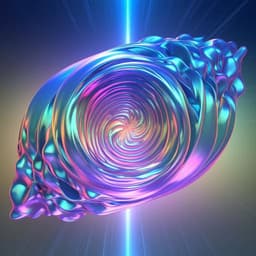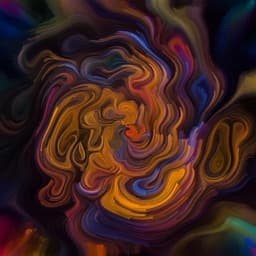Introduction
Time crystals are a novel phase of matter exhibiting spontaneous symmetry breaking in time. While initially explored in time-independent systems, research shifted to periodically driven (Floquet) systems, where discrete time crystals (DTCs) emerge when the system's response period is an integer multiple of the drive period. This paper focuses on dissipative DTCs, which are crucial for applications like quantum computing and memory, as dissipation can either destroy or enable time crystallinity depending on the system. This work presents the experimental demonstration and theoretical analysis of all-optical, room-temperature DTCs in Kerr-nonlinear microresonators, a platform enabling the observation of phenomena like defect-carrying DTCs and phase transitions, paving the way for chip-scale time crystals for real-world applications.
Literature Review
The concept of time crystals, temporal analogs to spatial crystals, was introduced by Frank Wilczek in 2012. Initial research focused on continuous time translation symmetry breaking in undriven systems, but later work highlighted the potential of periodically driven systems to exhibit discrete time crystal behavior. Studies explored various aspects, including fractional DTCs and quasi-crystals, and investigated the role of interactions, disorder, and ergodicity breaking in isolated systems. The study of dissipative DTCs in open quantum systems is relatively recent, focusing on how dissipation affects the stability and properties of time crystallinity.
Methodology
The experimental setup uses a Kerr-nonlinear optical microcavity simultaneously pumped by two continuous-wave (CW) lasers with an arbitrary frequency separation (multiples of the free spectral range, FSR). This dichromatic pumping, combined with a dissipative optical soliton, creates a modulated background waveform that acts as a rotating lattice trap for the solitons. The system's dynamics are described by a modified Lugiato-Lefever equation (LLE) that accounts for detuning, damping, and two-pump driving. Numerical simulations, using both split-step Fourier transform and adaptive-step Runge-Kutta methods, were performed to model soliton formation and DTC behavior. The experiments utilize a prism-coupled high-Q whispering gallery mode (WGM) magnesium fluoride (MgF2) crystalline resonator. The output is analyzed using an optical spectrum analyzer (OSA) and a radio frequency spectrum analyzer (RFSA) to identify subharmonic generation and assess the coherence of the pulse train. The self-injection locking technique was employed to stabilize the lasers to cavity modes. The experimental results are compared to numerical simulations for validation.
Key Findings
The research experimentally demonstrates and theoretically analyzes the formation of all-optical, room-temperature DTCs in a Kerr-nonlinear microresonator. The key findings include:
1. **Realization of m-tupling DTCs:** The experiments successfully created DTCs where the response period is an integer multiple (m) of the drive period, with m values significantly larger than 2 (big DTCs). The value of m is tunable by adjusting the laser pump frequencies.
2. **Observation of defect-carrying DTCs:** The study observed DTCs with defects analogous to vacancies and dislocations in spatial crystals, demonstrating the creation of imperfect DTCs.
3. **Robustness and long-range order:** The generated DTCs exhibited remarkable robustness and temporal long-range order, maintaining stability over extended durations far exceeding those of previous experiments.
4. **Excellent agreement between theory and experiment:** Numerical simulations based on a modified LLE accurately predicted the experimental observations, demonstrating the validity of the theoretical model.
5. **Subharmonic generation as a signature:** The emergence of subharmonics between the pump frequencies in the frequency domain serves as a clear signature of DTC formation.
6. **Multi-stability observed:** The system exhibited multi-stability, where different DTC states (with varying m values) coexist depending on the laser parameters.
Discussion
The results confirm the existence of dissipative DTCs in an all-optical platform meeting the criteria for DTC formation: discrete time translation symmetry (TTS), spontaneous emergence of symmetry-broken states, robustness over a parameter range, and description via a mean-field approach. The experimental demonstration and theoretical modeling's strong agreement validate the concept and demonstrate a versatile platform for studying DTCs. The observation of defect-carrying DTCs extends the understanding of time crystalline phases. The room-temperature and chip-scale nature of the system opens doors for practical applications.
Conclusion
This research successfully demonstrated all-optical, room-temperature dissipative discrete time crystals using a novel dichromatic pumping scheme in a Kerr-nonlinear microresonator. The findings show the feasibility of creating and manipulating DTCs with tunable properties and defects. Future research could focus on exploring phase transitions in DTCs, investigating interactions between multiple DTCs, and exploring applications in quantum computing and precision timekeeping.
Limitations
The study primarily focuses on a specific type of Kerr-nonlinear microresonator. The generalizability of the findings to other systems requires further investigation. While the self-injection locking technique simplifies soliton generation, it might introduce limitations related to the stability and controllability of the laser locking process. The current experimental setup focuses on relatively small values of 'm'; further exploration of significantly larger m values is necessary to fully understand the scalability of the system.
Related Publications
Explore these studies to deepen your understanding of the subject.







